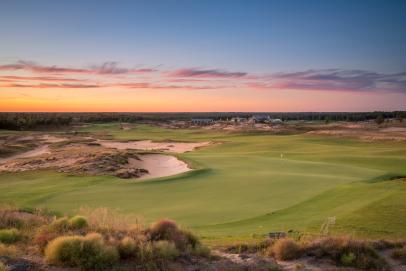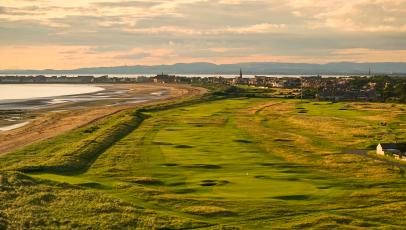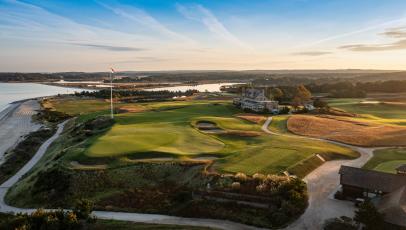
The most important development in golf-course architecture during the past 20 years is the elevation of sand-based sites. Encouraged by the success of destinations like Bandon Dunes, developers have spent this time scouring the globe for sandy, dunes-like properties on which to construct new courses and lure golfers, several of which make their debut on the Golf Digest 2024-2025 World’s 100 Greatest Courses, our ranking of courses outside the United States.
This is nothing new. The first golf courses—the links of Scotland, England, Ireland and Wales—were born from sand. Early golfers forged their way through the gorsed and grassy landscapes of dunes, kettles, eskers and seaside plains, chasing their balls while developing holes, which over time became fully realized courses. Advancements in construction methods throughout the 20th century enabled courses to be built anywhere on any type of land, negating the need for pure natural movements, but sand—near a coast or not—remains the medium that produces golf that most resembles the game as it was conceived.
This year’s ranking reflects a reappraisal of the virtues of sand and, more specifically, links golf. In the 2022-2023 World’s 100 Greatest Courses ranking, 40 courses that could be classified as links were represented (defined here as coastal courses built on mostly sandy linksland). This year that number is 54. This does not count the numerous inland courses built on sand, including those in the Melbourne Sand Belt region, highlighted by Royal Melbourne’s West Course, ranked fifth, or the heathland courses southwest of London, topped by Sunningdale’s Old Course at No. 12.
Just as important as quantity in demonstrating the appreciation for sand is the upward movement of links courses in the rankings. Nine of the top 10 courses are links, up from six in 2022-2023. Links courses, in fact, jumped a collective 351 places in the poll, marked most notably by Trump International surging 33 places, followed by Cruden Bay (30 places), Prestwick (28), Portmarnock (Championship) and Royal Troon (25 each) and Kingsbarns (24). Links stalwarts like Royal Hague (No. 48), designed in 1939 by Charles Alison, Royal St. David’s in Wales (No. 76), Enniscrone in Ireland (No. 87) and Paraparaumu Beach in New Zealand (No. 96) enter or reenter the ranking. “Secondary” courses at established clubs also get love, with Turnberry, Portrush, St. Andrews and several others placing two courses on the list for the first time.
We urge you to click through to each individual course page for bonus photography, drone footage and expanded reviews. Plus, you can now leave your own ratings on the courses you’ve played … to make your case why your favorite should be ranked higher.

100. (NR) Cabo del Sol (Cove Club, formerly Ocean Course)
Cabo San Lucas, Baja Sur, Mexico




96. (NR) Paraparaumu Beach Golf Club
Paraparaumu Beach, Kapiti Coast, New Zealand



93. (NR) Walton Heath Golf Club (New)
Walton-on-the-Hill, Surrey, England


91. (NR) St. Andrews Links (New)
St Andrews, Scotland



88. (91) County Sligo Golf Club - Rosses Point (Colt Championship)
Rosses Point, Co. Sligo, Ireland

87. (NR) Enniscrone (The Dunes)
Enniscrone, Co. Sligo, Ireland

86. (94) Cape Breton Highland Links
Ingonish Beach, Nova Scotia, Canada










76. (NR) Royal St. David's Golf Club
Harlech, Wales



73. (T-62) Jack's Point Golf Club
Jack's Point, Queenstown, New Zealand




69. (NR) Walton Heath Golf Club (Old)
Walton-on-the-Hill, Surrey, England

68. (65) The Bluffs Ho Tram Strip
Bà Rịa, Vũng Tàu, Vietnam



65. (47) Leopard Creek Country Club
Malelane, Mpumalanga, South Africa

64. (33) Mid Ocean Club
St. George's, Bermuda



61. (89) Prestwick Golf Club
Prestwick, Scotland

60. (88) Banff Springs Golf Club (Thompson)
Banff, Alberta, Canada






54. (20) Casa de Campo (Teeth of the Dog)
La Romana, Dominican Republic


52. (64) Machrihanish Golf Club
Machrihanish, Scotland

51. (72) Castle Stuart Golf Links
Inverness, Scotland

50. (42) Kawana Golf Resort (Fuji)
Ito, Shizuoka, Japan

49. (NR) St. Patrick's Links
Downings, Co. Donegal, Ireland




45. (75) Jasper Park Lodge Golf Club
Jasper, Alberta, Canada




41. (49) Punta Espada Golf Club
Punta Cana, Dominican Republic


39. (37) Barnbougle Lost Farm
Bridport, Tasmania, Australia














25. (39) Cabot Links
Inverness, Nova Scotia, Canada



22. (46) Kingsbarns Golf Links
Kingsbarns, Scotland

21. (51) Cruden Bay Golf Club
Cruden Bay, Scotland






15. (21) Cape Kidnapper's Golf Course
Te Awanga, Hawke's Bay, New Zealand

14. (12) Cape Wickham Golf Links
Wickham, Tasmania, Australia

13. (10) Cabot Cliffs
Inverness, Nova Scotia, Canada


11. (11) Kingston Heath Golf Club
Cheltenham, Victoria, Australia





6. (7) Muirfield
Muirfield, Scotland



3. (9) The Old Course at St Andrews
St Andrews, Scotland

2. (3) Royal Dornoch Golf Club (Championship)
Dornoch, Scotland

Explore our brand-new course reviews experience with individual course pages for bonus photography, drone footage and expanded reviews of top international courses and all 17,000-plus courses in the United States. Post your own ratings for courses you’ve played … and tell us where it should be ranked.






